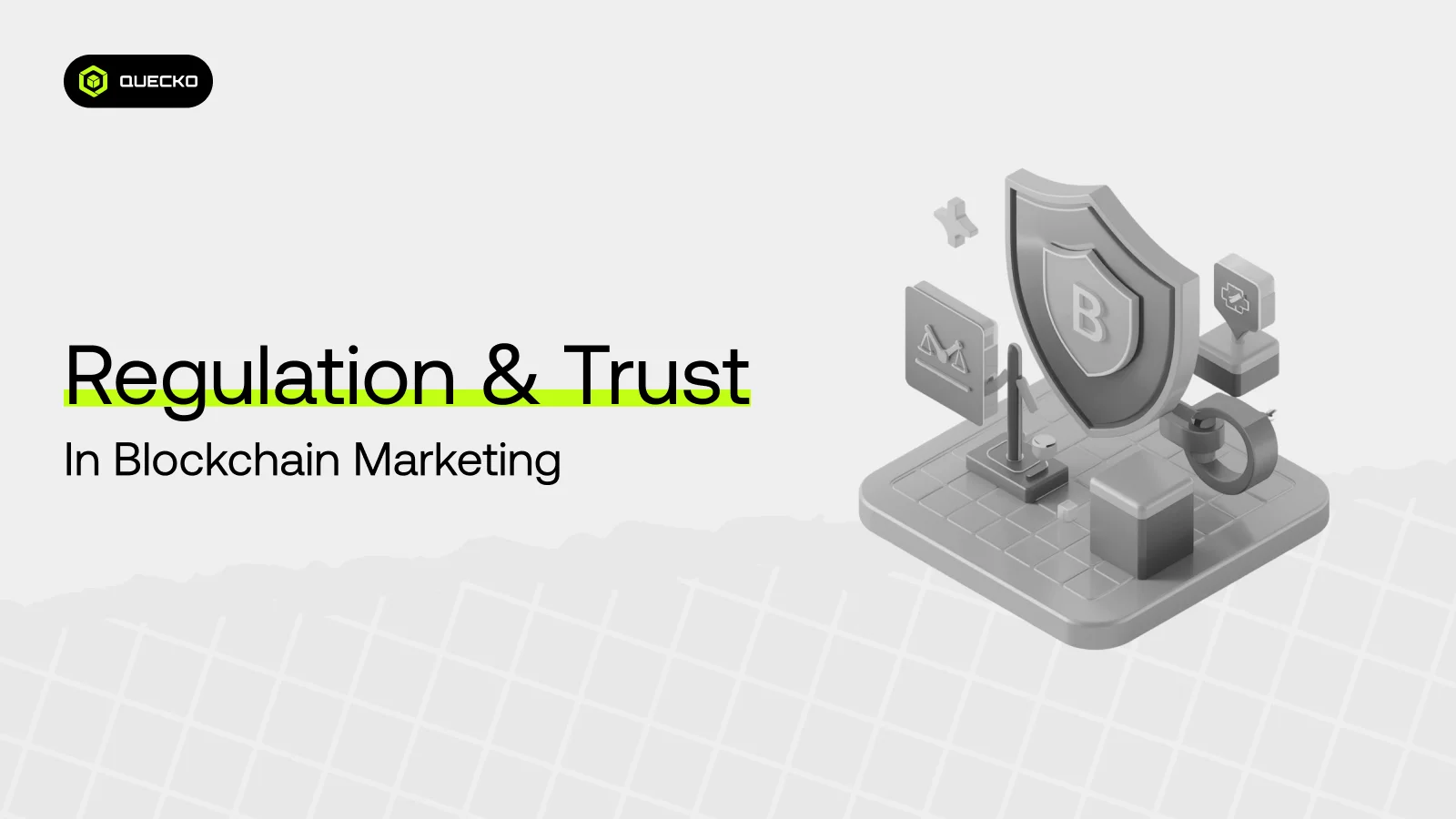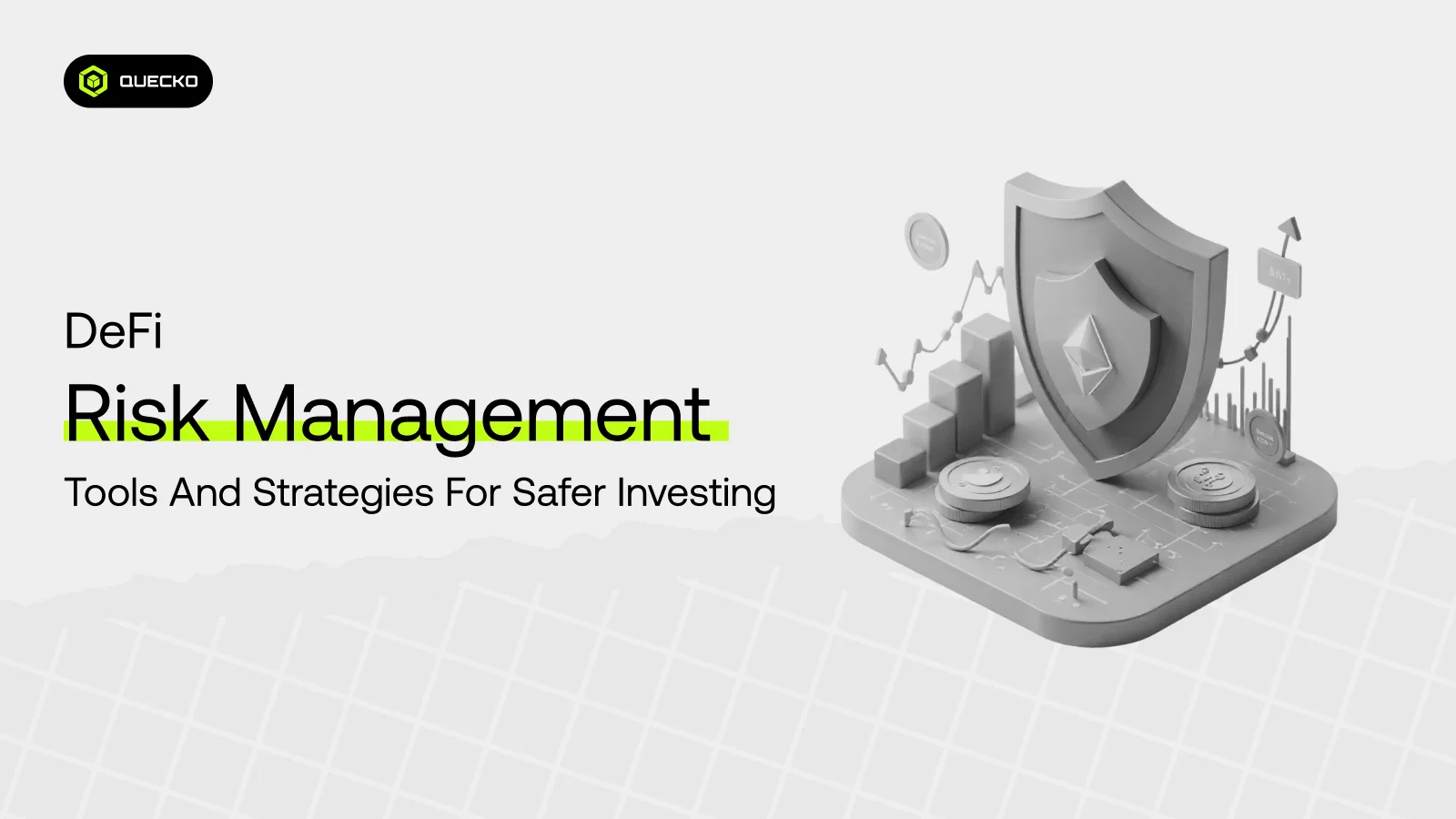Why Regulation Could Be Blockchain Marketing’s Secret Weapon
Explore how regulation, transparency, and trust shape blockchain marketing. Learn about global frameworks, compliance, and ethical Web3 growth.

Blockchain, tokenization, and decentralized tech are shaking up the marketing world in all the right ways. Thanks to blockchain, smart contracts, and decentralized networks, marketers now have access to tools that bring real transparency, secure data, and direct peer-to-peer connections. Think beyond the usual ads, we’re talking about new business models built around digital assets, NFTs, and crypto innovations. Whether it’s making supply chains more transparent or redefining what “ownership” means through networks like Ethereum, blockchain is rewriting the rules of how trust and value are built online.
But with these advances come serious challenges around regulation and data protection. How do marketers ensure they are fair, lawful, and deserving of consumer trust while navigating an evolving legal landscape?
This blog explores:
- What blockchain marketing is, and why trust matters more than ever
- The regulatory challenges and evolving frameworks globally
- Key tensions: transparency vs. privacy; decentralization vs. accountability
- How trust is built (or lost) in blockchain marketing
- Best practices and future directions
1. What is Blockchain Marketing & Why Trust Matters
Blockchain marketing refers broadly to marketing practices that leverage blockchain technology or distributed-ledger systems. This can include:
Crypto-asset or digital asset promotion
- Non-fungible tokens (NFTs) used for branding, engagement, or digital collectibles
- Proof of authenticity and supply chain traceability for transparent product journeys
- Advertising or influencer campaigns around blockchain projects
- Smart contracts, Web3 platforms, DAOs, and other decentralized tools that automate and secure transactions
Trust becomes central in this domain because:
- Many blockchain projects are new, unproven, and may involve financial risk tied to digital assets.
- There have been scams, misleading token launches, and rug pulls, eroding confidence in the market.
- Since blockchain promises immutability and transparency, any missteps such as misleading claims, lack of data protection, or failure to disclose risks are especially damaging.
Regulation plays a dual role, protecting consumers (investors, users) and giving legitimacy to projects. Without regulatory clarity, marketing risks legal penalties, consumer distrust, or worse market collapse for a project.
2. Regulatory Challenges & Frameworks Around the World
Blockchain rules are popping up fast but they’re all over the place. Different countries are taking different approaches, which makes things tricky for projects and marketers.
The EU is leading the way with MiCA, a clear framework for crypto, NFTs, and marketing disclosures. In the U.S., things are still a bit tangled between the SEC and CFTC, but new laws like FIT21 aim to bring more clarity. Meanwhile, places like UAE and Singapore are using sandbox models and licensing to encourage innovation, while Pakistan and France are shaping their own policies for crypto marketing and data protection.
The big challenge? These rules don’t always line up. Cross-border compliance, token definitions, and privacy issues make it hard to create one smooth global system. That’s why more international cooperation is needed to build trust and keep innovation moving.
Global Regulatory Moves
Let’s look at what regulators are doing globally, and the particular challenges that come with governing blockchain technology, smart contracts, and emerging blockchain protocols.
European Union – Markets in Crypto-Assets (MiCA): Adopted in 2023 and fully in effect since December 2024, MiCA provides a uniform regulatory framework for crypto assets across the EU. It sets rules for transparency, disclosures, marketing, stablecoins, and non-fungible tokens (NFTs). It also addresses concerns like data protection and anti–money laundering compliance, helping ensure that blockchain-based promotions and digital transactions meet strict security and privacy standards.
United States – Financial Innovation & Technology for the 21st Century Act (FIT21): Passed by the House in 2024, this act clarifies how digital assets are treated under U.S. law, assigning regulatory authority between the SEC and CFTC depending on whether a token qualifies as a security or a commodity. FIT21 also emphasizes transparency in blockchain-based advertising and the use of smart contracts, particularly those tied to decentralized financial systems or supply chain verification networks.
Pakistan: In 2025, Pakistan launched the Pakistan Crypto Council (PCC) under its Finance Ministry to develop policy, regulation, and frameworks for blockchain technology and digital assets. Its focus areas include KYC/AML oversight (addressing money laundering risks), data protection, and the regulation of advertising and marketing within the crypto and non-fungible token ecosystem.
France: France has actively refined its laws on influencer and digital marketing, especially for financial and crypto products. One proposed bill sought to limit influencer promotions to licensed crypto firms; later, it was revised to require registration with the AMF (Financial Markets Authority). These laws help ensure transparency in blockchain campaigns and align with data protection and anti–money laundering standards.
United Arab Emirates: The UAE continues to position itself as a global blockchain hub. Through clear licensing structures in free zones like DMCC and ADGM, it attracts blockchain and crypto firms operating under compliant blockchain protocols. This regulatory clarity strengthens trust in the market by ensuring that projects follow established guidelines on disclosures, data protection, and marketing fairness—creating a safer environment for innovation across decentralized networks.
Key Regulatory Issues & Challenges
Some of the key Regulatory issues and challenges faced are:
Advertising and Promotions
When it comes to marketing powered by blockchain technology or distributed ledger systems, advertising integrity becomes crucial. The questions that normally arise are:
- What claims are being made about returns, guarantees, or risks associated with digital assets?
- Are influencers clearly disclosing sponsored or promoted content, especially when campaigns are tied to self-executing contracts or token-based reward systems?
- Are advertisements misleading, or do they accurately reflect the underlying trust architectures that blockchain promises?
Consumer Protection & Fraud Prevention
With new technologies come new risks. Regulators focus on preventing scams, rug pulls, and Ponzi schemes that exploit investors’ trust in distributed ledger transparency. Ensuring KYC and AML compliance is vital in promotions, particularly when self-executing contracts automate payments or rewards. In addition, supply chain applications using blockchain can enhance transparency, but they must also meet legal and ethical standards for user data handling.
Data Privacy & Immutable Data vs. Rights
The immutability of blockchain technology creates tension with privacy laws like the GDPR, which grant individuals rights such as the “right to be forgotten.” Since blockchain records cannot easily be altered or deleted, questions arise:
- Who controls user data?
- Who acts as the data controller or processor in a distributed ledger environment? Finding a balance between immutability, data protection, and individual privacy remains a central challenge in blockchain marketing.
Clarity in Definitions
Regulatory uncertainty often stems from inconsistent terminology. Is a tokenized asset a “security,” a “commodity,” or a form of digital utility? What qualifies as a “crypto asset,” “token,” or “NFT”? Legal clarity determines how trust architectures are built and how marketing activities can proceed lawfully.
Cross-Border Issues
Blockchain marketing operates across global distributed ledgers, but jurisdictional laws differ widely. A compliant promotion in one region may violate another’s advertising or user data laws. Coordinating cross-border standards is critical to building regulatory trust.
Enforcement
Even when rules exist, enforcing them remains difficult. Geo-blocking, anonymous promoters, and decentralized platforms complicate oversight. As self-executing contracts and trust architectures evolve, enforcement models must adapt to ensure accountability without undermining the decentralized ethos that defines blockchain technology.
3. Tensions & Trade-Offs
The rise of blockchain technology has introduced a revolutionary framework for transparency, accountability, and peer-to-peer interaction. Yet, the very qualities that make it transformative/immutability, decentralization, and openness also create deep tensions and trade-offs when it comes to regulation and trust in marketing. Balancing innovation with compliance has become one of the defining challenges for blockchain-driven communication, especially in a landscape where trust is both a promise and a potential point of failure.
Blockchain marketing exists within broader digital ecosystems that are reshaping industries through digital transformation, digital currencies, decentralized applications (dApps), and blockchain-powered decentralized finance (DeFi). While these technologies expand opportunity, they also demand stronger governance, ethical oversight, and global cooperation to protect both innovation and financial stability.
1. Transparency vs. Privacy
One of the most significant tensions lies between transparency, a core pillar of permissionless blockchains and privacy, which is central to global data protection and consumer rights frameworks such as the GDPR.
Marketers in blockchain ecosystems often promote transparency as a trust-building mechanism. Campaigns emphasize public ledgers, verifiable supply chain records, and immutable transactions. However, these same attributes can conflict with privacy laws that guarantee individuals’ rights to delete or correct their data.
In a distributed ledger environment, once user data is recorded, it is nearly impossible to erase creating friction with the “right to be forgotten.” As a result, projects must design new trust architectures that honor both blockchain transparency and users’ legal privacy rights. Techniques like zero-knowledge proofs, selective disclosure, and off-chain storage are emerging to bridge this gap, yet full reconciliation remains a complex and evolving issue.
2. Decentralization vs. Accountability
Decentralized networks empower communities, eliminate single points of control, and foster on-chain governance through DAOs and community voting. However, this decentralization introduces regulatory challenges, as traditional legal frameworks are built on the assumption of identifiable intermediaries and accountable entities.
In contrast, blockchain marketing often operates through DAOs, smart contracts, and self-executing contracts that distribute decision-making. When false claims, scams, or manipulative promotions occur, enforcement becomes difficult: Who is the liable party; the developer, the DAO, the influencer, or the algorithm?
This ambiguity complicates efforts to ensure compliance and consumer protection. Regulators demand identifiable “data controllers” and responsible intermediaries, while blockchain’s ethos resists central authority. The trade-off lies in maintaining decentralization without undermining ethical responsibility or financial stability.
3. Innovation vs. Compliance
Blockchain marketing thrives on innovation; new engagement models like non-fungible tokens (NFTs), tokenized communities, and decentralized applications that redefine consumer interaction. Yet these same innovations blur legal lines. A token used for rewards might qualify as a digital asset, a security, or even part of an initial coin offering (ICO), depending on jurisdictional interpretation.
Over-regulation risks stifling innovation and slowing the progress of digital transformation, while under-regulation creates openings for scams, misinformation, terrorist financing, and money laundering. Marketers must therefore operate in a dynamic middle ground,innovating responsibly while ensuring compliance.
Emerging frameworks use smart contracts to embed compliance logic directly into digital advertising and promotional systems. Automated KYC/AML verification, real-time audits via distributed ledgers, and transparent reporting mechanisms all help reconcile creativity with legal boundaries.
4. Globalization vs. Jurisdiction
Blockchain is inherently global. Campaigns run on permissionless blockchains transcend borders, reaching audiences across continents within seconds. Yet, regulation remains national and fragmented.
A marketing strategy compliant with the EU’s MiCA framework might still violate the U.S. SEC’s securities standards or advertising restrictions elsewhere. The global supply chain of digital advertising—spanning influencers, affiliates, token issuers, and marketing DAOsadds additional complexity.
This jurisdictional fragmentation fuels uncertainty. Projects must decide whether to adopt a unified, stringent global compliance model or localize marketing strategies for each region. The trade-off impacts scalability, agility, and operational costs, making cross-border marketing one of blockchain’s most intricate challenges.
5. Immutability vs. Adaptability
The immutability of blockchain data builds trust by ensuring that once a transaction or message is recorded, it cannot be altered. However, digital advertising and marketing thrive on flexibility—brands often need to correct, update, or retract claims.
Once a promotional claim or record is embedded in a permissionless blockchain, it becomes permanent. While this strengthens authenticity and auditability, it complicates legal compliance in cases of misleading information. Immutable records also challenge regulators’ ability to enforce corrections, especially under data protection laws.
To overcome this, marketers are adopting hybrid models: using off-chain databases for editable content and on-chain proofs for authenticity. This balance preserves trust without compromising adaptability—an essential element of ethical blockchain marketing.
6. Automation vs. Human Oversight
The use of smart contracts and self-executing contracts in marketing automates trust, enabling instant, rule-based distribution of payments, commissions, or rewards. Yet, full automation is not without risks.
A small coding error can misallocate funds or bypass compliance filters, leading to significant financial and reputational damage. Moreover, when disputes arise, regulators and courts struggle to determine how to interpret self-executing contracts under existing legal frameworks.
True trust in blockchain marketing therefore requires both on-chain governance and human oversight—a hybrid system where code enforces transparency and human judgment ensures ethical accountability.
7. Trust by Design: The Emerging Middle Ground
Despite these tensions, a balanced approach is emerging; often termed “trust by design.” This philosophy integrates legal compliance, ethical standards, and blockchain technology from the inception of a marketing initiative, rather than as a postscript.
- Data protection principles are built into trust architectures and campaign workflows.
- Distributed ledgers provide transparent audits without exposing sensitive user data.
- Smart contracts ensure that all digital advertising disclosures are automated and tamper-proof.
- Global frameworks align innovation, compliance, and financial stability to sustain responsible growth.
“Trust by design” recognizes that credibility in blockchain marketing isn’t created solely through cryptography or compliance; it arises from their fusion. Brands and projects that internalize this principle will lead the evolution of marketing in digital ecosystems, where transparency, fairness, and accountability coexist with innovation and decentralization.
4. How Trust is Built (or Lost) in Blockchain Marketing
Here are the factors that tend to make consumers believe or distrust marketing within blockchain ecosystems.
Ways Trust is Built
Transparency Clear, accurate communication about what a project does, its risks, and tokenomics remains foundational. Projects that openly publish audits, proofs, and on-chain verification—such as supply chain traceability or smart contract audits—reinforce credibility. In the era of digital transformation, such openness allows participants to independently validate claims using blockchain technology, enhancing integrity in a trustless exchange environment.
Regulatory Compliance Adherence to established frameworks—such as licensing, AML/KYC laws, and marketing disclosures—plays a critical role in building consumer confidence. When a project’s operations are transparent and subject to oversight by recognized authorities, it signals accountability and commitment to lawful promotion of digital assets and decentralized applications.
Reputation & Credibility of Actors The credibility of the team behind a campaign matters significantly. Verified credentials, proven experience, and independent audits or references from credible partners demonstrate professionalism. By leveraging on-chain governance and community voting mechanisms, blockchain projects can further legitimize decision-making processes and strengthen user confidence in their digital ecosystems.
Immutable Evidence Because distributed ledgers are inherently tamper-resistant, proofs such as timestamps, ownership verification, and authenticity claims can be independently confirmed. This immutability, rooted in blockchain technology, empowers consumers to verify marketing statements without relying on intermediaries—an essential part of fostering a transparent and self-sovereign identity culture.
Consumer Rights & Recourse Even in decentralized systems, mechanisms for consumers to raise complaints or seek redress are key to sustainable trust. Clear terms and conditions, transparent fees, and secure handling of digital rights and personal data are fundamental expectations in this space.
How Trust is Lost
Misleading Claims / Overpromising Overstated claims of guaranteed profits or “risk-free” returns erode credibility. When projects or promoters fail to balance optimism with risk transparency, they undermine the authenticity that blockchain ecosystems depend on.
Lack of Disclosures Failing to disclose paid promotions, influencer sponsorships, or vested interests damages both project and community trust. This is especially critical in on-chain governance environments, where hidden conflicts of interest can distort decision-making.
Data Breaches or Misuse of Data While blockchain’s design supports strong privacy and security, improper handling of user data or leaks in connected systems can cause irreversible harm. Ethical data protection practices remain central to sustaining trust in digital assets marketing.
Lack of Regulatory Clarity or Operating in Grey Areas When projects operate without clear jurisdictional guidance or ignore existing compliance standards, consumers may perceive higher risk. Regulatory uncertainty can foster skepticism, even among tech-savvy participants familiar with decentralized networks.
Unrealistic Tokenomics or Business Models Unstable or speculative models that deliver short-term hype but collapse over time lead to distrust and ad fraud within communities. Sustainable token economies, transparent governance, and verifiable smart contract logic are essential to maintaining long-term consumer confidence.
5. Best Practices & Frameworks for Trustworthy Blockchain Marketing
Given all that, what should blockchain projects, marketers, and regulators do; or at least consider, to build sustainable trust and accountability within blockchain ecosystems?
Clear Disclosures in Marketing Materials
Transparency is the foundation of credible marketing. Every promotional material should include clear disclosures about potential risks, token volatility, and investment uncertainty. If an influencer is paid, that partnership must be explicitly stated to prevent ad fraud and manipulation. If a token carries no guarantees or has speculative value, that must also be clarified. These disclosures help uphold digital rights and ensure consumers make informed decisions in a trustless exchange environment.
Comply with Local & International Laws
Projects should always understand the jurisdictions they’re marketing into and comply with relevant advertising, securities, cybersecurity regulations, and data privacy laws. Since digital transformation has blurred geographic boundaries, engaging legal counsel with multi-jurisdictional experience is essential. Compliance is not just about risk mitigation; it’s a trust-building mechanism that strengthens the reputation of blockchain-based initiatives.
Transparency in Tokenomics / Project Information
Publish comprehensive whitepapers, technical audits, and team information. Open access to code repositories, smart contract addresses, and token supply data reinforces the integrity of blockchain ecosystems. Where possible, leverage on-chain proofs to verify claims, ensuring accountability and authenticity. Such transparency reduces misinformation and strengthens user confidence.
User Education
Empower users through accessible explanations of how blockchain technology supports the product or service. Educational initiatives should emphasize both the potential and the risks, especially regarding volatility, security, and privacy. By promoting awareness, marketers contribute to a more informed digital ecosystem that values transparency and shared responsibility.
Data Privacy–First Design
Adopt a “privacy by design” philosophy. Before launching campaigns, assess what user data is collected, how long it’s stored, and whether it’s truly necessary to store it on-chain. Avoid recording personal data on immutable public ledgers unless robust privacy-preserving mechanisms—like encryption, off-chain storage with on-chain hashes, or self-sovereign identity frameworks—are in place. This ensures compliance with global data protection laws while maintaining trust.
Governance & Accountability Mechanisms
Build on-chain governance models and internal compliance teams to oversee ethical marketing practices. Consider third-party audits, industry certifications, or self-regulatory bodies to add additional layers of credibility. Transparent governance builds consumer confidence and demonstrates that the project operates under responsible digital transformation principles.
Regulators Should Provide Clarity & Flexibility
Regulators have a vital role in balancing innovation with protection. Laws should clearly define permissible marketing activities and required disclosures while remaining flexible enough to accommodate emerging blockchain models. Engagement with industry players allows regulators to stay aligned with technological evolution and prevent overreach. Instead of blanket bans, risk-based regulation offers a more adaptive and fair approach.
Use Technology to Support Trust
Technology can enforce integrity at scale. Smart contracts can automatically uphold promises—like reward distribution or refund guarantees—without manual intervention. Immutable ledgers can verify testimonials, performance metrics, and supply chain provenance. Such technical verifiability ensures trust remains measurable, not just claimed.
6. Examples & Case Studies
Some real-world examples help illustrate both success and failure within global blockchain ecosystems, showing how regulation, innovation, and trust production intersect in practice.
Aura Blockchain Consortium: A prime example of collaborative innovation, the Aura initiative unites luxury brands like LVMH and Prada under a shared framework of consortium governance. By using blockchain to create digital product passports that verify authenticity and provenance, the consortium strengthens interorganizational trust among brands, suppliers, and consumers. This model aligns with the EU’s sustainability and ecodesign regulations, representing how the Internet of trust can evolve beyond speculation—using algorithmic trust to enhance transparency and accountability instead of hype.
UK’s Crackdown on Misleading Crypto Ads: In response to growing retail exposure to digital assets, the UK Treasury extended its advertising rules for financial products to include crypto marketing. Under this framework, promotions must be “fair, clear, and not misleading,” ensuring that blockchain-related campaigns are anchored in ethical communication and financial integrity. This move reflects a regulatory approach aimed at protecting the Internet of trust from misinformation and unchecked speculation.
France’s Influencer Regulation: France has taken a pioneering role in regulating influencer marketing related to crypto or digital assets. Influencers must register with the AMF (Financial Markets Authority) and disclose sponsorships or paid partnerships. By mandating transparency, France enhances algorithmic trust and accountability across social and decentralized autonomous organizations (DAOs) involved in promotions.
Pakistan’s Regulatory Pivot: Pakistan’s Pakistan Crypto Council (PCC) marks an important shift toward structured blockchain policy. By introducing KYC/AML frameworks, advertising oversight, and consumer protection measures, the PCC aims to foster a legitimate environment for innovation and investment in digital assets. This regulatory evolution is part of a broader movement toward trust production, ensuring that blockchain adoption contributes to sustainable growth and a secure Internet of trust.
7. The Evolving Regulatory Landscape: What’s New & What’s Coming
Here are the trends to watch that will shape how regulation and trust evolve in blockchain marketing and the broader management of digital assets.
Uniform Regulations in Multi-Nation Regions: Regulatory convergence is becoming a defining trend. Frameworks like the EU’s Markets in Crypto-Assets (MiCA) are paving the way for unified oversight across borders. When entire blocs adopt common rules, it strengthens interorganizational trust and simplifies compliance for decentralized autonomous organizations (DAOs) and token issuers operating across multiple jurisdictions. These models often rely on consortium governance, ensuring collaborative policy development and consistent enforcement throughout global blockchain ecosystems.
Digitization and Certification of Ads: Regulators are increasingly introducing digital systems for ad verification and certification. Marketing materials must now be backed by verifiable data, stored in traceable repositories, and, in some cases, pre-approved by regulators. This digitization supports trust production by ensuring marketing around asset tokenization, NFTs, and cryptocurrency exchange listings is transparent and evidence-based.
Stricter Influencer Marketing Rules: Because influencers frequently promote digital assets and blockchain-based products, authorities are tightening transparency requirements. Disclosure of paid promotions, affiliations, and risks is now mandatory in many jurisdictions, especially for campaigns tied to DAOs or cryptocurrency exchanges. These changes aim to prevent misleading claims and promote ethical engagement across blockchain ecosystems.
Stablecoin Regulation Stablecoins are commonly used in blockchain promotions as “safe” or reference tokens. Regulators are now mandating stronger backing, audit standards, and disclosure requirements. These measures enhance trust production and ensure that stablecoins used within marketing or asset tokenization initiatives uphold financial integrity.
Emphasis on AML / KYC / Consumer Protection Regulators have heightened scrutiny on campaigns involving digital assets, particularly where anonymity or lack of verification is involved. Cryptocurrency exchanges and marketing agencies are expected to comply with anti-money laundering (AML) and know-your-customer (KYC) obligations. This ensures interorganizational trust across partners and platforms, aligning blockchain innovation with consumer safety.
Data Privacy Regulations and Blockchain Tension The ongoing tension between immutable ledgers and personal data rights continues to be refined through evolving privacy laws. As consortium governance models emerge, organizations are developing frameworks that balance transparency with compliance, ensuring digital assets marketing aligns with ethical and legal data practices.
Regulatory Bodies Creating Guidance, Not Just Rules Modern regulators are moving from rigid enforcement to collaborative engagement. Advertising and financial authorities are now producing detailed guidance for virtual asset service providers, helping them interpret evolving laws. This consultative model fosters interorganizational trust and encourages innovation without sacrificing accountability, helping establish a more transparent and resilient Internet of trust within blockchain marketing.
8. Implications & Recommendations for Different Stakeholders
Here’s what marketers, blockchain projects, regulators, and consumers should consider as trust and regulation continue to evolve in blockchain marketing.
For Marketers & Blockchain Projects: Projects operating within modern blockchain ecosystems must strategically map out the regulatory jurisdictions where their audiences reside and, where necessary, tailor campaigns accordingly. Collaboration with legal, compliance, and regulatory technology (RegTech) teams early in the process helps prevent future disputes and ensures consistent transparency. Marketers should focus on trustless technology and ethical design; building systems where verification happens through digital signatures, notarised contracts, and auditable ledgers. This enables transparency and accountability without relying on intermediaries. Incorporating digital escrow mechanisms can further assure stakeholders of fairness in token or NFT-related promotions. When working with decentralized autonomous organizations (DAOs) or under consortium governance structures, maintaining consistent messaging, verified audits, and on-chain authenticity proofs becomes crucial. Finally, designing data architectures that respect privacy; such as combining off-chain storage with on-chain hashes, ensures compliance with data protection laws while maintaining blockchain’s inherent integrity.
For Regulators & Policy Makers: Regulators and central banks must engage with industry participants, including DAOs and marketing consortia, to understand emerging business models before implementing overly rigid controls. Forward-thinking oversight should include clear guidelines on marketing disclosures, influencer accountability, and responsible promotion of trustless technologies. By leveraging regulatory technology, authorities can streamline compliance monitoring, create standardized frameworks, and enable safer cross-border marketing. Consortium governance models, where industry players and regulators collaborate can enhance transparency, while harmonized regulations can reduce global compliance burdens and minimize fraud. Education remains key: public awareness initiatives should empower consumers to recognize credible projects and avoid deceptive advertising.
For Consumers / Users: In an era defined by digital transformation, consumers must remain vigilant. Before engaging with a blockchain or crypto project, users should verify whether it provides independent audits, public disclosures, and transparent digital signatures for all key transactions. Be cautious of “too good to be true” promises and understand that tokenized assets carry inherent volatility and no guaranteed returns. Prefer projects that demonstrate open governance, ethical standards, and verifiable proof-of-performance systems. Consumers should also recognize that digital escrow tools and notarised contracts can offer an additional layer of protection, reinforcing accountability in an increasingly decentralized, trustless marketplace.
9. Case: Pakistan & Emerging Economies
In Pakistan, there are distinct implications for emerging economies navigating the evolving space of blockchain technology and digital assets.
Regulatory frameworks in these markets are often less mature, creating uncertainty that can either deter investment or leave consumers vulnerable to exploitation. The establishment of the Pakistan Crypto Council (PCC) represents a significant step toward structured oversight and trust-building within the national blockchain ecosystem. As frameworks evolve, attention to clear payment terms, transparent advertising, and consistent compliance will be vital for attracting responsible participation and mass-market adoption.
In regions with lower financial literacy or limited understanding of blockchain, misleading marketing can have disproportionate negative impacts. Educational initiatives and public awareness programs are therefore essential to ensure safe participation. Moreover, as marketing moves online, the role of demand-side platforms, supply-side platforms, and ad networks becomes increasingly important in verifying ad integrity and preventing scams within digital campaigns.
Compliance with AML/KYC regulations remains crucial, not only for adhering to local laws but also for fostering international credibility and partnerships. Integrating digital identity management tools into blockchain marketing can further enhance trust, allowing users to verify authenticity without compromising privacy.
Finally, cross-border marketing, especially via global crypto exchanges or digital advertising platforms creates regulatory complexities. Local authorities may struggle to enforce compliance beyond national borders, underscoring the importance of coordinated efforts between regulators, marketers, and technology providers to ensure transparent and ethical blockchain communication worldwide.
10. Looking Ahead: What Would Ideal Regulation & Trust in Blockchain Marketing Look Like?
What might be a “gold standard” for regulating and building trust? Here are elements of an ideal future:
- Clear Legal Definitions
- Token / crypto asset / NFT / digital asset clearly defined.
- Clarity over what constitutes a security vs commodity vs utility token.
- Transparent Marketing / Requirement of Disclosures
- All promotions (print, social, influencer) must include disclosures: risks, compensation, affiliations.
- Regulatory Oversight & Licensing Where Appropriate
- Entities offering marketing around financial / crypto projects may need licensing.
- Mechanisms for pre-approval of certain claims or ads in high risk markets.
- Uniform Minimum Standards + Local Flexibility
- For regions, uniform baseline standards (e.g. MiCA-like).
- Allow for local cultural/legal differences, but don’t allow “regulation arbitrage” (i.e. operating in weak-regulation jurisdictions to market elsewhere).
- Enforcement Mechanisms & Remedies
- Penalties for misleading marketing / fraud.
- Legal recourse for consumers.
- Swift takedown / correction of false/misleading promotions.
- Strong Data Privacy Protections
- Personal data usage, storage, deletion rights respected.
- Technologies like zero-knowledge proofs, encryption, off-chain storage used to reconcile blockchain immutability with data subject rights.
- Mandatory Audits / Verifications
- Smart contracts audited; token supply verified.
- Third-party attestations helpful.
- Education & Industry Self-Regulation
- Industry bodies, standards, codes of conduct.
- Consumer education so people know what disclaimers to look for, what questions to ask.
Conclusion
Blockchain marketing offers significant promise: a more transparent, accountable way to do brand building, product launches, customer engagement. But its novelty, the financial risks, and the rapid pace of change mean that trust cannot be assumed; it must be earned through adherence to rules, transparent communication, and ethical behaviour. Regulation is not just a check on wrongdoing: done well, it underpins legitimacy and long-term adoption.
For marketers, projects, regulators, and users, the path ahead involves cooperation. Regulatory clarity, responsible marketing, consumer protection, and technological tools designed with privacy and trust in mind will be the cornerstones. As blockchain becomes more integrated into mainstream marketing, balancing innovation with responsibility will be the defining challenge.
Date
1 minute agoShare on
Related Blogs

Why Regulation Could Be Blockchain Marketing’s Secret Weapon
1 minute ago

DeFi Risk Management: Tools and Strategies for Safer Investing
2 days ago

The Rise of Layer-2 Gaming Economies: Faster, Cheaper
6 days ago

Decentralized Exchanges: The Future of Trading or a Passing Trend?
9 days ago







